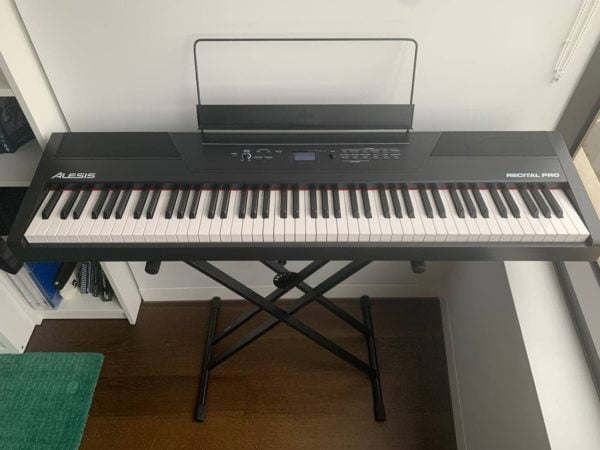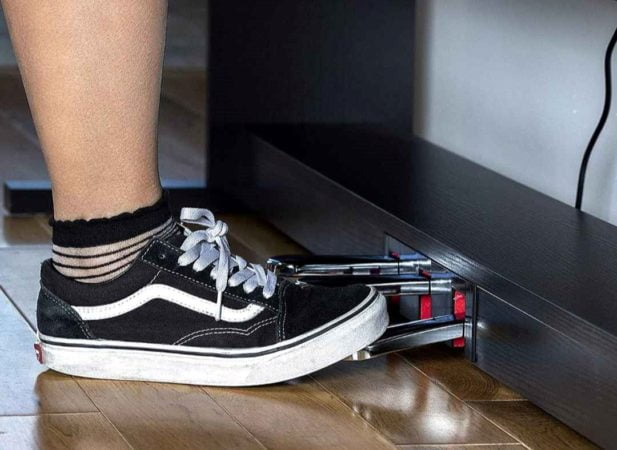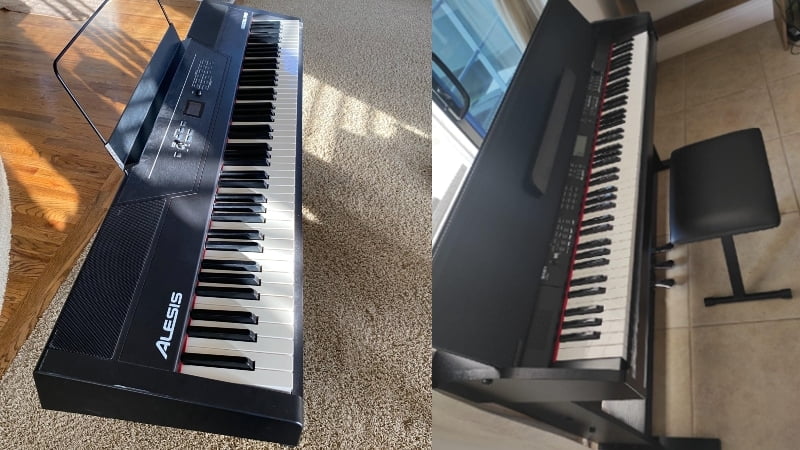Should you buy the Alesis Virtue or the Alesis Recital Pro?
Both pianos are on the affordable end of the spectrum and offer a wide range of features fit for beginner pianists. In fact, if you’re on the hunt for your first digital piano, we highly recommend choosing between these two options.
But in this Alesis Virtue vs Recital Pro comparison, there could only be one winner. And with its wider set of tones and piano features, I ended up choosing the Alesis Virtue.
And while I thought the Alesis Virtue was the better investment overall, the details are a bit more nuanced. The Alesis Recital Pro is one of my favorite entry level pianos because of its great hammer action and different playing modes.
Either of these pianos would serve any beginner very well. But in the end, the Alesis Virtue seemed to come with a better set of features and offered more value for the price.
Alesis Virtue vs Recital Pro: Comparison Chart




Last update on 2025-07-06 / Affiliate links / Images from Amazon Product Advertising API
Alesis Virtue vs Recital Pro: The Features
Finding a winner between these two options was pretty difficult. So, to make it easier I decided to compare each of the features head to head and by the end I’ll have a final score. And after comparing the tone, feel, and piano features of both options, the Alesis Virtue came out on top with a score of 2-1.
It was a very close fight, so keep reading to learn how the Alesis Virtue beat out the Recital Pro.
Tone
The winner: Alesis Virtue
Both of these pianos have pretty similar tones, as they are entry level models in the Alesis catalog. However, I had to choose a winner. And while the tone quality of these pianos was very similar, the Alesis Virtue has way more voices than the Alesis Recital Pro, which is why it eventually won out in this comparison.
+Tone Generation
It was hard to find specific information on the tone engines of both these pianos. However, when giving these instruments a listen and analyzing the specs, I figured they both used samples to generate tones.
Now, for entry level pianos, sampling is the go-to way to produce sounds since you can produce high-quality voices without busting the bank. The secret to getting good voices when using samples is to load the pianos with high-quality samples.
And after closely listening to both instruments, I found that the samples were pretty high. While there was a slight digital texture to the tones, both of them sounded pretty close to an acoustic piano.
Granted, I have to say the Alesis Recital Pro sports a more realistic tone, which is probably due to higher-quality samples or better speakers. However, it isn’t that far-off with the Alesis Virtue, either. And when testing both pianos with headphones, the tones were barely distinguishable.
+Sound Library
The main reason I found that the Alesis Virtue has a better tone is because of its sound library. When I tested out the Virtue, I was very surprised to find it had over 360 different tones!
These voices ranged from piano, electric piano, organ, synth, bass, all the way to drum and percussion tones. With console digital pianos, you don’t usually get this much variety, which was a huge point in Alesis Virtue’s favor.
With that said, not all of these tones are the best quality. While I found the piano, bass, synth, and even the strings tones to be great, the other more abstract tones like SFX and drums were lackluster, to say the least.
However, compared to the measly 12 tones on the Alesis Recital, I would take the flexibility and versatility of the Alesis Virtue any day.
When you’re starting out your journey into piano, it’s important for you to be able to experiment with a wide range of different sounds. So, since the Alesis Virtue comes with over 360 different voices with which you can experiment, it was the obvious choice between the two.

Feel
The winner: Alesis Recital Pro
The Alesis Virtue hit the right notes on every single feature except for feel. My biggest complaint with the Alesis Virtue is that it doesn’t feature weighted keys. On the flip side, the Alesis Recital Pro features fully-weighted keys, which instantly makes it feel more realistic than the Alesis Virtue, which is what gave it the point for this specific feature.
+Hammer Action
If you’re a beginner pianist looking for a practice instrument, weighted keys are a very important feature. If you have weighted keys, the piano will have a more accurate response that really feels like an acoustic instrument. And since beginners need to take time to get used to the feel of an acoustic piano, investing in a model with weighted keys is always a good idea.
The Alesis Recital Pro features fully-weighted keys. It would have been nciec to see progressive hammer action on this model, but that sadly wasn’t the case. With that said, the weight on the Alesis Recital Pro is pretty realistic and offers a similar feel to an acoustic piano, but it’s definitely missing out on some key details.
While I did have my own complaints about the hammer action on the Alesis Recital Pro, it is still much better than the non-weighted keys on the Alesis Virtue.
Non-weighted keys are a big deal when choosing a digital piano since they take away a lot of the realism when you touch the keys. However, if you’re a beginner with light hands or a child learning to play the piano, non-weighted keys might actually help you familiarize yourself with the notes and proper hand positions more easily.
But as you get better and more familiar with the piano, you’ll likely find yourself craving the weight of a real acoustic instrument, which is why the Alesis Recital Pro took this point over the Alesis Virtue.
Piano Features
The winner: Alesis Virtue
The Alesis Virtue didn’t necessarily come with more features and playing modes than the Alesis Recital Pro, but it did come with more useful ones. If you’re a beginner or a novice player, you’ll find a lot of uses for the different playing modes on the Alesis Virtue. And while the Recital Pro did offer a couple of cool playing modes and effects, they simply weren’t as useful as the ones I found on the Alesis Virtue.
+Playing Modes
There are two playing modes present on the Recital Pro and the Alesis Virtue. These are split and dual mode. Dual mode is sometimes referred to as layering mode, which is very important if you’re looking to play around with all of these different modes.
Split mode is great for performing solo or playing with a band. This mode allows you to split the piano into two distinct zones, each with a different voice. For example, the right side of the piano can be playing a piano voice while the left side is playing a bass or organ voice.
The result is the illusion that you’re playing two instruments at a time, which is a great way to fill up your sound when performing live.
Dual mode is another great performance and jamming feature. This mode allows you to blend or layer two different voices at the same time. This comes in handy if you’re accompanying another musician, or if you just want a bit more body and uniqueness to your piano’s tone.
The one additional playing mode on the Alesis Virtue, however, is recording mode. This is great for beginners since you can record your playing, listen back on it, and really find areas that are in need of improvement.
The Alesis Recital Pro doesn’t come with recording mode, which is a major drawback for any pianist. It is worth mentioning, however, that almost anyone can record audio nowadays using their phone, but having the feature built into the piano would have made things much easier.
+Connectivity

In terms of connectivity, both of these pianos definitely hit the mark. You can plug in external speakers or headphones into both pianos for private practice or for performances, which is a huge plus. Additionally, both pianos support USB MIDI connectivity, which allows you to basically use them as MIDI controllers for virtual instruments and piano learning apps.
However, the Alesis Virtue still holds a slight edge over the Recital Pro in this regard. This is because the Alesis Virtue comes with and supports a three-pedal unit, just like an acoustic piano. The Alesis Recital Pro only comes with a single pedal unit and you likely won’t be able to plug in a three-pedal unit into the instrument.
Alesis Virtue vs Recital Pro: The Similarities
These are two very different pianos, but they both still have a fair amount of similarities. For example, they both have 128-note maximum polyphony. For beginner pianos, this is actually very good since most entry-level options leave you with just 64 note polyphony.
Additionally, these pianos both have reverb and chorus effects. As a pianist, these are likely the only piano effects you’re going to need, especially at the start. And since most beginner’s pianos don’t come with any effects at all, it’s a neat little feature that you can find on both the Alesis Virtue and Recital Pro.
Quick Rundown of the Alesis Virtue
- Everything You Need - 88 full-sized keys with velocity sensitivity and adjustable touch response, 3 pedals (sustain, soft, sostenuto), easy-to-assemble wooden stand with music rest and an adjustable piano bench.
- Superior Sound - 360 built-in premium voices with the ability to split or layer 2 voices simultaneously; 30-watt stereo speakers (15W X 2) and 128-note max polyphony for realistic sound and playability
- Compose, Create, Record - One-touch song mode with 160 built-in accompaniment styles; 80 demo songs; Record mode enables you to record and then listen back to your performance
- Powerful Educational Features - Lesson mode divides the keyboard into two sections with the same pitch and voice; Built-in metronome with a 30-280 BPM range; Backlit LCD screen clearly shows chord names and notation
- Learn Piano Today - Includes Skoove 3-month premium subscription for expert interactive online piano lessons
Last update on 2025-07-06 / Affiliate links / Images from Amazon Product Advertising API
Quick Rundown of the Alesis Recital Pro
- A Digital Piano That’s Tailored to You - Feature-packed electric keyboard with 88 premium full-sized weighted hammer action keys with adjustable touch response to suit your preferred playing style
- Premium Sounds - 12 voices (Incl. Acoustic Piano, Electric Piano, Organ, Synth, and Bass), built-in FX: Chorus, Modulation, Reverb, and two built in 20W speakers for clear, room-filling sound
- All The Right Connections - ¼” sustain pedal input (pedal not included), ¼” stereo headphone output for private practice and stereo outputs for connection to speakers / amplifiers
- Play the Keyboard Wherever You Go - Power via the included power adapter or 6 D cell batteries (not included) for professional piano performance anywhere
- Powerful Educational Features - Standard, split, layer, record and lesson modes with 128-note max polyphony and Skoove 3 month premium subscription for expert interactive online piano lessons
Last update on 2025-07-06 / Affiliate links / Images from Amazon Product Advertising API
Product Videos
Related Articles to Alesis Virtue
Related Articles to Alesis Recital Pro
- Alesis Recital Pro vs Williams Legato III: Discover the Best Piano for Your Home
- Alesis Recital Pro vs Roland Go Piano 88 Comparison: Which Is The Best Portable Digital Piano?
- Alesis Recital Pro vs Yamaha NP32 Comparison: Discover the Best Piano for Your Home
- Kawai ES110 Vs Alesis Recital Pro: Should You Shell Out for the Kawai ES110?
- Alesis Recital Pro vs Prestige Comparison: Choosing the Best Entry-Level Alesis Piano
- Alesis Recital Pro vs Casio CDP-135: Which Is the Best Beginner’s Digital Piano?
- Alesis Recital Pro vs Roland FP-30: Finding the Best Digital Piano on a Budget
- Alesis Recital Pro vs Casio CDP-S150 Comparison: Which Is The Best Portable Digital Piano?
- Alesis Recital Pro vs Casio PX 160: Which Piano Comes Out On Top?
- Alesis Recital Pro vs Roland FP 10: Why You Should Go For The Alesis Recital Pro
- Alesis Recital Pro vs Korg B2 Comparison: Which Digital Piano Should You Get?
- Alesis Recital Pro vs Williams Allegro 3 Comparison: Which One Is Worth Your Money?
- Alesis Recital Pro vs Yamaha P125 Comparison: Which Is The Best Portable Digital Piano?
- Alesis Recital vs Alesis Recital Pro: Should You Invest In The Recital Pro?
- Alesis Recital Pro vs Yamaha P45: Which Should You Get As Your First Piano?
- Donner DEP-20 vs Alesis Recital Pro Comparison: Two Great Pianos Designed for Beginners
- Alesis Prestige Artist vs Recital Pro: Which Is the Best Alesis Piano for Beginners?
- Yamaha P71 vs Alesis Recital Pro: Which Digital Piano is the Best Option for Beginners?
Reference
- Alesis Virtue: https://www.sweetwater.com/store/detail/Virtue–alesis-virtue-88-key-digital-piano-with-wood-stand-and-bench
- Alesis Recital Pro: https://www.alesis.com/products/view/recital-pro
Lulacruza is an electronic folk duo operating at the junction of the hypermodern and the ancient. Our music weaves together hypnotic female singing, South American folk instruments and electronic processing, while channeling pulsating waves from the source of creation.
Lalucruza is also a community where you can connect with other music lovers to collaborate, exchange ideas and share knowledge. A platform for who wants to learns the basics of playing piano, guitar, drum masters’ technique, etc.. is the premise of our website.
